Green Derived Zinc Oxide (ZnO) for the Degradation of Dyes from Wastewater and Their Antimicrobial Activity: A Review
Abstract
:1. Introduction
2. Pollutants
2.1. Organic Pollutants
2.2. Natural Pollutants

3. Treatment Methods Used to Purify Wastewater
3.1. Advance Oxidation Process (AOP)
Photocatalysis
3.2. Metal Oxides
ZnO Nanoparticles
3.3. Green Chemistry
Green ZnO Using Plant Extracts
3.4. Green Derived ZnO as Photocatalyst for Dye Degradation
3.5. Green Derived ZnO Antimicrobial Agent
4. Challenges of ZnO Material as Photocatalyst and Antimicrobial Agent
5. Conclusions and Future Perspectives
Author Contributions
Funding
Data Availability Statement
Acknowledgments
Conflicts of Interest
References
- Meissner, R.; Steyn, M.; Moyo, E.; Shadung, J.; Masangane, W.; Nohayi, N.; Jacobs-Mata, I. South African local government perceptions of the state of water security. Environ. Sci. Policy 2018, 87, 112–127. [Google Scholar] [CrossRef]
- Reig, P.; Maddocks, A.; Gassert, F. World’s 36 Most Water-Stressed Countries; World Resources Institute: Washington, DC, USA, 2013. [Google Scholar]
- Xiang, Y.; Wu, H.; Li, L.; Ren, M.; Qie, H.; Lin, A. A review of distribution and risk of pharmaceuticals and personal care products in the aquatic environment in China. Ecotoxicol. Environ. Saf. 2021, 213, 112044. [Google Scholar] [CrossRef] [PubMed]
- Cui, L.; Li, H.; Yang, K.; Zhu, L.; Xu, F.; Zhu, Y. Trends in Analytical Chemistry Raman biosensor and molecular tools for integrated monitoring of pathogens and antimicrobial resistance in wastewater. Trends Anal. Chem. 2021, 143, 116415. [Google Scholar] [CrossRef]
- Lu, F.; Astruc, D. Nanomaterials for removal of toxic elements from water. Coord. Chem. Rev. 2018, 356, 147–164. [Google Scholar]
- Ong, C.B.; Ng, L.Y.; Mohammad, A.W. A review of ZnO nanoparticles as solar photocatalysts: Synthesis, mechanisms and applications. Renew. Sustain. Energy Rev. 2018, 81, 536–551. [Google Scholar] [CrossRef]
- Mohamed, A.A.; Abu-elghait, M.; Ahmed, N.E.; Salem, S.S. Eco-friendly Mycogenic Synthesis of ZnO and CuO Nanoparticles for In Vitro Antibacterial, Antibiofilm, and Antifungal Applications. Biol. Trace Elem. Res. 2021, 199, 2788–2799. [Google Scholar] [CrossRef] [PubMed]
- Ayele, A.; Getachew, D.; Kamaraj, M.; Suresh, A. Phycoremediation of Synthetic Dyes: An Effective and Eco-Friendly Algal Technology for the Dye Abatement. J. Chem. 2021, 2021, 9923643. [Google Scholar] [CrossRef]
- Bhuyan, B.; Paul, B.; Purkayastha, D.D.; Dhar, S.S.; Behera, S. Facile synthesis and characterization of zinc oxide nanoparticles and studies of their catalytic activity towards ultrasound-assisted degradation of metronidazole. Mater. Lett. 2016, 168, 158–162. [Google Scholar] [CrossRef]
- Senthilkumar, S.R.; Sivakumar, T. Green tea (Camellia sinensis) mediated synthesis of zinc oxide (ZnO) nanoparticles and studies on their antimicrobial activities. Int. J. Pharm. Pharm. Sci. 2014, 6, 461–465. [Google Scholar]
- Mahlaule-Glory, L.M.; Mbita, Z.; Ntsendwana, B.; Mathipa, M.M.; Mketo, N.; Hintsho-Mbita, N.C. ZnO nanoparticles via Sutherlandia frutescens plant extract: Physical and biological properties. Mater. Res. Express 2019, 6, 085006. [Google Scholar] [CrossRef]
- Munyai, S.; Mahlaule-Glory, L.M.; Hintsho-Mbita, N.C. Green synthesis of Zinc sulphide (ZnS) nanostructures using S. frutescences plant extract for photocatalytic degradation of dyes and antibiotics. Mater. Res. Express 2022, 9, 015001. [Google Scholar] [CrossRef]
- Selvaraj, V.; Karthika, T.S.; Mansiya, C.; Alagar, M. An over review on recently developed techniques, mechanisms and intermediate involved in the advanced azo dye degradation for industrial applications. J. Mol. Struct. 2021, 1224, 129195. [Google Scholar] [CrossRef]
- Lee, K.M.; Lai, C.W.; Ngai, K.S.; Juan, J.C. Recent developments of zinc oxide based photocatalyst in water treatment technology: A review. Water Res. 2016, 88, 428–448. [Google Scholar] [CrossRef] [PubMed]
- Zewde, D.; Geremew, B. Biosynthesis of ZnO nanoparticles using Hagenia abyssinica leaf extracts, their photocatalytic and antibacterials activities. Environ. Pollut. Bioavailab. 2022, 34, 224–235. [Google Scholar] [CrossRef]
- Kulal, D.; Kodialbail, V.S. Visible light mediated photocatalytic dye degradation using Ag2O/AgO-TiO2 nanocomposite synthesized by extracellular bacterial mediated synthesis—An eco-friendly approach for pollution abatement. J. Environ. Chem. Eng. 2021, 9, 105389. [Google Scholar] [CrossRef]
- Roopan, S.M.; Elango, G.; Priya, D.D.; Asharani, I.V.; Kishore, B.; Vinayprabhakar, S.; Pragatheshwaran, N.; Mohanraj, K.; Harshpriya, R.; Shanavas, S.; et al. Sunlight mediated photocatalytic degradation of organic pollutants by statistical optimization of green synthesized NiO NPs as catalyst. J. Mol. Liq. 2019, 293, 111509. [Google Scholar] [CrossRef]
- Pradinaud, C.; Northey, S.; Amor, B.; Bare, J.; Benini, L.; Berger, M.; Boulay, A.M.; Junqua, G.; Lathuillière, M.J.; Margni, M.; et al. Defining freshwater as a natural resource: A framework linking water use to the area of protection natural resources. Int. J. Life Cycle Assess. 2019, 24, 960–974. [Google Scholar] [CrossRef] [PubMed]
- Wang, H.; Hecht, S.; Kline, D.; Leber, A.L. Staphylococcus aureus and methicillin resistance detection directly from pediatric samples using PCR assays with differential cycle threshold values for corroboration of methicillin resistance. J. Microbiol. Methods 2019, 159, 167–173. [Google Scholar] [CrossRef] [PubMed]
- Stanley, H.O.; Ugboma, C.J.; Uzoaru, P.C. Investigations on Bacteriological Quality of Tap Water Sources within the University of Port Harcourt. J. Adv. Microbiol. 2019, 16, 1–5. [Google Scholar] [CrossRef]
- Ashwini, J.; Aswathy, T.R.; Rahul, A.B.; Thara, G.M.; Nair, A.S. Synthesis and Characterization of Zinc Oxide Nanoparticles Using Acacia caesia Bark Extract and Its Photocatalytic and Antimicrobial Activities. Catalysts 2021, 11, 1507. [Google Scholar] [CrossRef]
- Jeukens, J.; Freschi, L.; Kukavica-Ibrulj, I.; Emond-Rheault, J.G.; Allard, C.; Barbeau, J.; Cantin, A.; Charette, S.J.; Déziel, E.; Malouin, F.; et al. The Pseudomonas aeruginosa Population among Cystic Fibrosis Patients in Quebec, Canada: A disease hot spot without known epidemic isolates. J. Clin. Microbiol. 2019, 57, 1–3. [Google Scholar] [CrossRef] [PubMed] [Green Version]
- Oves, M.; Aslam, M.; Rauf, M.A.; Qayyum, S.; Qari, H.A.; Khan, M.S.; Alam, M.Z.; Tabrez, S.; Pugazhendhi, A.; Ismail, I.M.I. Antimicrobial and anticancer activities of silver nanoparticles synthesized from the root hair extract of Phoenix dactylifera. Mater. Sci. Eng. C 2018, 89, 429–443. [Google Scholar] [CrossRef]
- Vijayakumar, S.; Krishnakumar, C.; Arulmozhi, P.; Mahadevan, S.; Parameswari, N. Biosynthesis, characterization and antimicrobial activities of zinc oxide nanoparticles from leaf extract of Glycosmis pentaphylla (Retz.) DC. Microb. Pathog. 2018, 116, 44–48. [Google Scholar] [CrossRef]
- Chai, Q.; Wu, Q.; Liu, T.; Tan, L.; Fu, C.; Ren, X.; Yang, Y.; Meng, X. Enhanced antibacterial activity of silica nanorattles with ZnO combination nanoparticles against methicillin-resistant Staphylococcus aureus. Sci. Bull. 2017, 62, 1207–1215. [Google Scholar] [CrossRef] [Green Version]
- Saini, M.; Yadav, S.; Rani, N.; Mushtaq, A.; Rawat, S.; Sain, K.; Maity, D. Biosynthesized zinc oxide nanoparticles using seed and bark extract of Azadirachta indica for antibacterial, photocatalytic and supercapacitor applications. Mater. Sci. Eng. B 2022, 282, 115789. [Google Scholar] [CrossRef]
- Sultana, S.; Mohammad, R.; Khan, Z.; Umar, K.; Ahmed, A.S.; Shahadat, M. SnO2–SrO based nanocomposites and their photocatalytic activity for the treatment of organic pollutants. J. Mol. Struct. 2015, 1098, 393–399. [Google Scholar] [CrossRef]
- Bilińska, L.; Blus, K.; Gmurek, M.; Ledakowicz, S. Coupling of electrocoagulation and ozone treatment for textile wastewater reuse. Chem. Eng. J. 2019, 358, 992–1001. [Google Scholar] [CrossRef]
- Sirelkhatim, A.; Mahmud, S.; Seeni, A.; Kaus, N.H.M.; Ann, L.C.; Bakhori, S.K.M.; Hasan, H.; Mohamad, D. Review on zinc oxide nanoparticles: Antibacterial activity and toxicity mechanism. Nano-Micro Lett. 2015, 7, 219–242. [Google Scholar] [CrossRef] [PubMed] [Green Version]
- Agarwal, H.; Kumar, S.V.; Rajeshkumar, S. A review on green synthesis of zinc oxide nanoparticles—An eco-friendly approach. Resour. Technol. 2017, 3, 406–413. [Google Scholar] [CrossRef]
- Rao, B.; Tang, R.-C. Green synthesis of silver nanoparticles with antibacterial activities using aqueous Eriobotrya japonica leaf extract. Adv. Nat. Sci. Nanosci. Nanotechnol. 2017, 8, 015014. [Google Scholar] [CrossRef] [Green Version]
- Zhu, X.; Pathakoti, K.; Hwang, H.-M. Green synthesis of titanium dioxide and zinc oxide nanoparticles and their usage for antimicrobial applications and environmental remediation. In Green Synthesis, Characterization and Applications of Nanoparticles; Elsevier: Amsterdam, The Netherlands, 2019; pp. 223–263. [Google Scholar]
- Umar, K.; Haque, M.M.; Mir, N.A.; Muneer, M.; Farooqi, I.H. Titanium Dioxide-mediated Photocatalysed Mineralization of Two Selected Organic Pollutants in Aqueous Suspensions. J. Adv. Oxid. Technol. 2016, 16, 252–260. [Google Scholar] [CrossRef]
- Al-Asfar, A.; Zaheer, Z.; Aazam, E.S. Eco-friendly green synthesis of Ag@Fe bimetallic nanoparticles: Antioxidant, antimicrobial and photocatalytic degradation of bromothymol blue. J. Photochem. Photobiol. B Biol. 2018, 185, 143–152. [Google Scholar] [CrossRef] [PubMed]
- Raja, S.; Ramesh, V.; Thivaharan, V. Green biosynthesis of silver nanoparticles using Calliandra haematocephala leaf extract, their antibacterial activity and hydrogen peroxide sensing capability. Arab. J. Chem. 2017, 10, 253–261. [Google Scholar] [CrossRef] [Green Version]
- Ahmed, S.; Chaudhry, S.A.; Ikram, S. A review on biogenic synthesis of ZnO nanoparticles using plant extracts and microbes: A prospect towards green chemistry. J. Photochem. Photobiol. B Biol. 2017, 166, 272–284. [Google Scholar] [CrossRef]
- Zaheer, Z. Biogenic synthesis, optical, catalytic, and in vitro antimicrobial potential of Ag-nanoparticles prepared using Palm date fruit extract. J. Photochem. Photobiol. B Biol. 2018, 178, 584–592. [Google Scholar] [CrossRef] [PubMed]
- Mohanraj, R. Antimicrobial Activities of Metallic and Metal Oxide Nanoparticles From Plant Extracts. In Antimicrobial Nanoarchitectonics; Elsevier: Amsterdam, The Netherlands, 2017; pp. 83–100. [Google Scholar]
- Hintsho, N.C.; Petrik, L.; Nechaev, A.; Titinchi, S.; Ndungu, P. Photo-catalytic activity of titanium dioxide carbon nanotube nano-composites modified with silver and palladium nanoparticles. Appl. Catal. B Environ. 2014, 156, 273. [Google Scholar]
- Bar, H.; Bhui, D.K.; Sahoo, G.P.; Sarkar, P.; De, S.P.; Misra, A. Green synthesis of silver nanoparticles using latex of Jatropha curcas. Colloids Surf. A Physicochem. Eng. Asp. 2009, 339, 134–139. [Google Scholar] [CrossRef]
- Nazir, A.; Raza, M.; Abbas, M.; Abbas, S.; Ali, A.; Ali, Z.; Younas, U.; Al-Mijalli, S.H.; Iqbal, M. Microwave assisted green synthesis of ZnO nanoparticles using Rumex dentatus leaf extract: Photocatalytic and antibacterial potential evaluation. Z. Phys. Chem. 2022. [Google Scholar] [CrossRef]
- Vijayakumar, S.; Vinoj, G.; Malaikozhundan, B.; Shanthi, S.; Vaseeharan, B. Plectranthus amboinicus leaf extract mediated synthesis of zinc oxide nanoparticles and its control of methicillin resistant Staphylococcus aureus biofilm and blood sucking mosquito larvae. Spectrochim. Acta Part A Mol. Biomol. Spectrosc. 2015, 137, 886–891. [Google Scholar] [CrossRef]
- Barbosa, M.O.; Moreira, N.F.F.; Ribeiro, A.R.; Pereira, M.F.R.; Silva, A.M.T. Occurrence and removal of organic micropollutants: An overview of the watch list of EU Decision 2015/495. Water Res. 2016, 94, 257–279. [Google Scholar] [CrossRef] [PubMed]
- Ali, H.R.; Hassaan, M.A. Applications of Bio-waste Materials as Green Synthesis of Nanoparticles and Water Purification. Adv. Mater. 2017, 6, 85. [Google Scholar]
- Sewu, D.D.; Lee, D.S.; Woo, S.H.; Kalderis, D. Decolorization of triarylmethane dyes, malachite green, and crystal violet, by sewage sludge biochar: Isotherm, kinetics, and adsorption mechanism comparison. Korean J. Chem. Eng. 2021, 38, 531–539. [Google Scholar] [CrossRef]
- İlkiz, B.A.; Beceren, Y.İ.; Candan, C. An Approach to Estimate Dye Concentration of Domestic Washing Machine Wastewater. Autex Res. J. 2021, 21, 172–181. [Google Scholar]
- Akbari, A.; Sabouri, Z.; Hosseini, H.A.; Hashemzadeh, A.; Khatami, M.; Darroudi, M. Effect of nickel oxide nanoparticles as a photocatalyst in dyes degradation and evaluation of effective parameters in their removal from aqueous environments. Inorg. Chem. Commun. 2020, 115, 107867. [Google Scholar] [CrossRef]
- Munyai, S.; Hintsho-Mbita, N.C. Green derived metal sulphides as photocatalysts for waste water treatment. A review. Curr. Res. Green Sustain. Chem. 2021, 4, 100163. [Google Scholar] [CrossRef]
- Shahnaz, T.; Bedadeep, D.; Narayanasamy, S. Investigation of the adsorptive removal of methylene blue using modified nanocellulose. Int. J. Biol. Macromol. 2022, 200, 162–171. [Google Scholar] [CrossRef]
- Noman, M.; Shahid, M.; Ahmed, T.; Niazi, M.B.K.; Hussain, S.; Song, F.; Manzoor, I. Use of biogenic copper nanoparticles synthesized from a native Escherichia sp. as photocatalysts for azo dye degradation and treatment of textile effluents. Environ. Pollut. 2020, 257, 113514. [Google Scholar] [CrossRef] [PubMed]
- Kumaravelan, S.; Seshadri, S.; Suresh, R.; Ravichandran, K.; Sathishkumar, P.; Shanthaseelan, K.; Suganthi, N. Effect of Zn dopant on SnO2 nano-pyramids for photocatalytic degradation. Chem. Phys. Lett. 2021, 769, 138352. [Google Scholar] [CrossRef]
- Mahdavi, K.; Zinatloo-Ajabshir, S.; Yousif, Q.A.; Salavati-Niasari, M. Enhanced photocatalytic degradation of toxic contaminants using Dy2O3-SiO2 ceramic nanostructured materials fabricated by a new, simple and rapid sonochemical approach. Ultrason. Sonochem. 2022, 82, 105892. [Google Scholar] [CrossRef] [PubMed]
- Vasantharaj, S.; Sathiyavimal, S.; Senthilkumar, P.; Kalpana, V.N.; Rajalakshmi, G.; Alsehli, M.; Elfasakhany, A.; Pugazhendhi, A. Enhanced photocatalytic degradation of water pollutants using bio-green synthesis of zinc oxide nanoparticles (ZnO NPs). J. Environ. Chem. Eng. 2021, 9, 105772. [Google Scholar] [CrossRef]
- Haque, A.; Bin Islam, K.; Mahbub, S.; Khan, J.M.; Hossian, J.; Hoque, A.; Halim, M.A.; Rahman, M.M.; Ahmad, A.; Ahmed, M.Z. Impact of ethanol and NaCl on the acid yellow dye mediated self-aggregation of sodium dodecyl sulfate: A combined investigation by conductivity and molecular dynamics simulation. J. Mol. Liq. 2022, 345, 117819. [Google Scholar]
- Raja, A.; Ashokkumar, S.; Marthandam, R.P.; Jayachandiran, J.; Khatiwada, C.P.; Kaviyarasu, K.; Raman, R.G.; Swaminathan, M. Eco-friendly preparation of zinc oxide nanoparticles using Tabernaemontana divaricata and its photocatalytic and antimicrobial activity. J. Photochem. Photobiol. B Biol. 2018, 181, 53–58. [Google Scholar] [CrossRef] [PubMed]
- Aarthi, T.; Madras, G. Photocatalytic degradation of rhodamine dyes with nano-TiO2. Ind. Eng. Chem. Res. 2007, 46, 7–14. [Google Scholar] [CrossRef]
- Jaitpal, S.; Naik, P.; Chakraborty, S.; Banerjee, S.; Paul, D. Exploring the concentration-dependent transport and the loss of rhodamine B, tartrazine, methylene blue, and amaranth dyes in common paperfluidic substrates. Results Surf. Interfaces 2022, 6, 100034. [Google Scholar] [CrossRef]
- Priyanka, U.; Lens, P.N.L. Light driven Aspergillus niger-ZnS nanobiohybrids for degradation of methyl orange. Chemosphere 2022, 298, 134162. [Google Scholar] [CrossRef]
- Cui, M.; Xie, Z.; Wang, M.; Zhang, X. Methyl orange-crosslinked polypyrrole hydrogel enabled N, O, S co-doped porous carbon for highly sensitive determination of three redox-active biomolecules. J. Electroanal. Chem. 2022, 913, 116282. [Google Scholar] [CrossRef]
- Yadav, A.; Dindorkar, S.S. Adsorption behaviour of hexagonal boron nitride nanosheets towards cationic, anionic and neutral dyes: Insights from first principle studies. Colloids Surfaces A Physicochem. Eng. Asp. 2022, 640, 128509. [Google Scholar] [CrossRef]
- Vela-Carrillo, A.Z.; Martínez, R.J.; Godínez, L.A.; Pérez-Bueno, J.D.J.; Espejel-Ayala, F.; Robles, I. Study of chemical, kinetic, and theoretical sorption properties of activated carbons obtained from agroindustrial origin: Comparison of anionic and cationic model molecules. Biomass Convers. Biorefin. 2022, 12, 1–18. [Google Scholar] [CrossRef]
- Attallah, O.A.; Al-Ghobashy, M.A.; Nebsen, M.; Salem, M.Y. Removal of cationic and anionic dyes from aqueous solution with magnetite/pectin and magnetite/silica/pectin hybrid nanocomposites: Kinetic, isotherm and mechanism analysis. RSC Adv. 2016, 6, 11461–11480. [Google Scholar] [CrossRef]
- Karaman, C.; Karaman, O.; Show, P.L.; Karimi-Maleh, H.; Zare, N. Congo red dye removal from aqueous environment by cationic surfactant modified-biomass derived carbon: Equilibrium, kinetic, and thermodynamic modeling, and forecasting via artificial neural network approach. Chemosphere 2022, 290, 133346. [Google Scholar] [CrossRef]
- Jiménez-Mancilla, N.P.; Aranda-Lara, L.; Morales-Ávila, E.; Camacho-López, M.A.; Ocampo-García, B.E.; Torres-García, E.; Estrada-Guadarrama, J.A.; Santos-Cuevas, C.L.; Isaac-Olivé, K. Electron transfer reactions in rhodamine: Potential use in photodynamic therapy. J. Photochem. Photobiol. A Chem. 2021, 409, 113131. [Google Scholar] [CrossRef]
- Rout, L.; Kumar, A.; Satish, K.; Achary, L.; Barik, B.; Dash, P. Ionic liquid assisted combustion synthesis of ZnO and its modification by Au–Sn bimetallic nanoparticles: An efficient photocatalyst for degradation of organic contaminants. Mater. Chem. Phys. 2019, 232, 339–353. [Google Scholar] [CrossRef]
- Brezová, V.; Čeppan, M.; Veselý, M.; Lapčík, L. Photocatalytic oxidation of 2,6-dichloroindophenol in the titanium dioxide aqueous suspension. Chem. Papers 1991, 45, 233–246. [Google Scholar]
- Rajan, P.I.; Vijaya, J.J.; Jesudoss, S.K.; Kaviyarasu, K.; Kennedy, L.J.; Jothiramalingam, R.; Al-Lohedan, H.A.; Vaali-Mohammed, M.A. Green-fuel-mediated synthesis of self-assembled NiO nano-sticks for dual applications-photocatalytic activity on Rose Bengal dye and antimicrobial action on bacterial strains. Mater. Res. Express 2017, 4, 100375. [Google Scholar] [CrossRef]
- Zeebaree, A.Y.S.; Rashid, R.F.; Zebari, O.I.H.; Albarwry, A.J.S.; Ali, A.F.; Zebari, A.Y.S. Sustainable engineering of plant-synthesized TiO2 nanocatalysts: Diagnosis, properties and their photocatalytic performance in removing of Methylene Blue dye from effluent. A. review. Curr. Res. Green Sustain. Chem. 2022, 5, 100312. [Google Scholar]
- Liu, X.-B.; Lu, H.-Y.; Huang, W.-M.; Kong, H.-S.; Ren, X.-B.; Lin, H.-B. Electrochemical Degradation of Nitrobenzene. Curr. Org. Chem. 2012, 16, 1967–1971. [Google Scholar] [CrossRef]
- Mohanty, S.S.; Kumar, A. Enhanced degradation of anthraquinone dyes by microbial monoculture and developed consortium through the production of specific enzymes. Sci. Rep. 2021, 11, 7678. [Google Scholar]
- Yang, W.; Li, Q.; Guo, S.; Sun, S.; Tang, A.; Liu, H.; Liu, Y. Rational design of Aspergillus flavus A5p1-immobilized cell system to enhance the decolorization of reactive blue 4 (RB4). Chin. J. Chem. Eng. 2022. [Google Scholar] [CrossRef]
- Orooji, Y.; Mohassel, R.; Amiri, O.; Sobhani, A.; Salavati-Niasari, M. Gd2ZnMnO6/ZnO nanocomposites: Green sol-gel auto-combustion synthesis, characterization and photocatalytic degradation of different dye pollutants in water. J. Alloys Compd. 2020, 835, 155240. [Google Scholar] [CrossRef]
- Honarmand, M.; Golmohammadi, M.; Naeimi, A. Biosynthesis of tin oxide (SnO2) nanoparticles using jujube fruit for photocatalytic degradation of organic dyes. Adv. Powder Technol. 2019, 30, 1551–1557. [Google Scholar] [CrossRef]
- Khani, R.; Roostaei, B.; Bagherzade, G.; Moudi, M. Green synthesis of copper nanoparticles by fruit extract of Ziziphus spina-christi (L.) Willd.: Application for adsorption of triphenylmethane dye and antibacterial assay. J. Mol. Liq. 2018, 255, 541–549. [Google Scholar] [CrossRef]
- Kanagamani, K.; Muthukrishnan, P.; Saravanakumar, K.; Shankar, K.; Kathiresan, A. Photocatalytic degradation of environmental perilous gentian violet dye using leucaena-mediated zinc oxide nanoparticle and its anticancer activity. Rare Met. 2019, 38, 277–286. [Google Scholar] [CrossRef]
- He, Y.; Li, X.; Wang, J.; Yang, Q.; Yao, B.; Zhao, Y.; Zhao, A.; Sun, W.; Zhang, Q. Synthesis, characterization and evaluation cytotoxic activity of silver nanoparticles synthesized by Chinese herbal Cornus officinalis via environment friendly approach. Environ. Toxicol. Pharmacol. 2017, 56, 56–60. [Google Scholar] [CrossRef] [PubMed]
- Cai, D.; Li, X.; Chen, J.; Jiang, X.; Ma, X.; Sun, J.; Tian, L.; Vidyarthi, S.K.; Xu, J.; Pan, Z.; et al. A comprehensive review on innovative and advanced stabilization approaches of anthocyanin by modifying structure and controlling environmental factors. Food Chem. 2022, 366, 130611. [Google Scholar] [CrossRef] [PubMed]
- De León-Condés, C.A.; Roa-Morales, G.; Martínez-Barrera, G.; Menchaca-Campos, C.; Bilyeu, B.; Balderas-Hernández, P.; Ureña-Núñez, F.; Toledo-Jaldin, H.P. Sulfonated and gamma-irradiated waste expanded polystyrene with iron oxide nanoparticles, for removal of indigo carmine dye in textile wastewater. Heliyon 2019, 5, e02071. [Google Scholar] [CrossRef]
- Slavin, Y.N.; Asnis, J.; Häfeli, U.O.; Bach, H. Metal nanoparticles: Understanding the mechanisms behind antibacterial activity. J. Nanobiotechnol. 2017, 15, 1–20. [Google Scholar] [CrossRef]
- Aisida, S.O.; Ugwoke, E.; Uwais, A.; Iroegbu, C.; Botha, S.; Ahmad, I.; Maaza, M.; Ezema, F.I. Incubation period induced biogenic synthesis of PEG enhanced Moringa oleifera silver nanocapsules and its antibacterial activity. J. Polym. Res. 2019, 26, 1–11. [Google Scholar] [CrossRef]
- Ishwarya, R.; Vaseeharan, B.; Kalyani, S.; Banumathi, B.; Govindarajan, M.; Alharbi, N.S.; Kadaikunnan, S.; Al-anbr, M.N.; Khaled, J.M.; Benelli, G. Facile green synthesis of zinc oxide nanoparticles using Ulva lactuca seaweed extract and evaluation of their photocatalytic, antibiofilm and insecticidal activity. J. Photochem. Photobiol. B Biol. 2018, 178, 249–258. [Google Scholar] [CrossRef] [PubMed]
- Padalia, H.; Moteriya, P.; Chanda, S. Green synthesis of silver nanoparticles from marigold flower and its synergistic antimicrobial potential. Arab. J. Chem. 2015, 8, 732–741. [Google Scholar] [CrossRef] [Green Version]
- Elhadi, D.; Lv, L.; Jiang, X.R.; Wu, H.; Chen, G.Q. CRISPRi engineering E. coli for morphology diversification. Metab. Eng. 2016, 38, 358–369. [Google Scholar] [CrossRef]
- Babu, B.; Cho, M.; Byon, C.; Shim, J. One pot synthesis of Ag-SnO2 quantum dots for highly enhanced sunlight-driven photocatalytic activity. J. Alloys Compd. 2018, 731, 162–171. [Google Scholar] [CrossRef]
- Ligaray, M.; Kim, N.H.; Park, S.; Park, J.S.; Park, J.; Kim, Y.; Cho, K.H. Energy projection of the seawater battery desalination system using the reverse osmosis system analysis model. Chem. Eng. J. 2020, 395, 125082. [Google Scholar] [CrossRef]
- Haq, S.; Rehman, W.; Waseem, M.; Shah, A.; Khan, A.R.; Rehman, M.U.; Ahmad, P.; Khan, B.; Ali, G. Green synthesis and characterization of tin dioxide nanoparticles for photocatalytic and antimicrobial studies. Mater. Res. Express 2020, 7, 025012. [Google Scholar] [CrossRef]
- Moreira, V.R.; Lebron, Y.A.R.; da Silva, M.M.; de Souza Santos, L.V.; Jacob, R.S.; de Vasconcelos, C.K.B.; Viana, M.M. Graphene oxide in the remediation of norfloxacin from aqueous matrix: Simultaneous adsorption and degradation process. Environ. Sci. Pollut. Res. 2020, 27, 34513–34528. [Google Scholar] [CrossRef] [PubMed]
- Shabani, M.; Younesi, H.; Pontié, M.; Rahimpour, A.; Rahimnejad, M.; Zinatizadeh, A.A. A critical review on recent proton exchange membranes applied in microbial fuel cells for renewable energy recovery. J. Clean. Prod. 2020, 264, 121446. [Google Scholar] [CrossRef]
- Saravanan, A.; Senthil Kumar, P.; Jeevanantham, S.; Karishma, S.; Tajsabreen, B.; Yaashikaa, P.R.; Reshma, B. Effective water/wastewater treatment methodologies for toxic pollutants removal: Processes and applications towards sustainable development. Chemosphere 2021, 280, 130595. [Google Scholar] [CrossRef]
- Mohamed Noor, M.H.; Ngadi, N.; Mohammed Inuwa, I.; Opotu, L.A.; Mohd Nawawi, M.G. Synthesis and application of polyacrylamide grafted magnetic cellulose flocculant for palm oil wastewater treatment. J. Environ. Chem. Eng. 2020, 8, 104014. [Google Scholar] [CrossRef]
- Saravanan, M.; Gopinath, V.; Chaurasia, M.K.; Syed, A.; Ameen, F.; Purushothaman, N. Green synthesis of anisotropic zinc oxide nanoparticles with antibacterial and cytofriendly properties. Microb. Pathog. 2018, 115, 57–63. [Google Scholar] [CrossRef] [PubMed]
- Paździor, K.; Wrębiak, J.; Klepacz-Smółka, A.; Gmurek, M.; Bilińska, L.; Kos, L.; Sójka-Ledakowicz, J.; Ledakowicz, S. Influence of ozonation and biodegradation on toxicity of industrial textile wastewater. J. Environ. Manage. 2017, 195, 166–173. [Google Scholar] [CrossRef] [PubMed]
- Paździor, K.; Klepacz-Smółka, A.; Ledakowicz, S.; Sójka-Ledakowicz, J.; Mrozińska, Z.; Żyłła, R. Integration of nanofiltration and biological degradation of textile wastewater containing azo dye. Chemosphere 2009, 75, 250–255. [Google Scholar] [CrossRef] [PubMed]
- Begum, S.; Devi, T.B.; Ahmaruzzaman, M. L-lysine monohydrate mediated facile and environment friendly synthesis of SnO2 nanoparticles and their prospective applications as a catalyst for the reduction and photodegradation of aromatic compounds. J. Environ. Chem. Eng. 2016, 4, 2976–2989. [Google Scholar] [CrossRef]
- Pavithra, N.S.; Lingaraju, K.; Raghu, G.K.; Nagaraju, G. Citrus maxima (Pomelo) juice mediated eco-friendly synthesis of ZnO nanoparticles: Applications to photocatalytic, electrochemical sensor and antibacterial activities. Spectrochim. Acta Part A Mol. Biomol. Spectrosc. 2017, 185, 11–19. [Google Scholar] [CrossRef] [PubMed]
- Al-Hamdi, A.M.; Rinner, U.; Sillanpää, M. Tin dioxide as a photocatalyst for water treatment: A review. Process. Saf. Environ. Prot. 2017, 107, 190–205. [Google Scholar] [CrossRef]
- Varghese, E.; George, M. Green Synthesis of Zinc Oxide Nanoparticles. Int. J. Adv. Res. Sci. Eng. 2015, 4, 307–314. [Google Scholar]
- Mostoni, S.; Pifferi, V.; Falciola, L.; Meroni, D.; Pargoletti, E.; Davoli, E.; Cappelletti, G. Tailored routes for home-made Bi-doped ZnO nanoparticles. Photocatalytic performances towards o-toluidine, a toxic water pollutant. J. Photochem. Photobiol. A Chem. 2017, 332, 534–545. [Google Scholar] [CrossRef]
- Arakha, M.; Roy, J.; Nayak, P.S.; Mallick, B.; Jha, S. Zinc oxide nanoparticle energy band gap reduction triggers the oxidative stress resulting into autophagy-mediated apoptotic cell death. Free Radic. Biol. Med. 2017, 110, 42–53. [Google Scholar] [CrossRef] [PubMed]
- Davar, F.; Majedi, A.; Mirzaei, A. Green synthesis of ZnO nanoparticles and its application in the degradation of some dyes. J. Am. Ceram. Soc. 2015, 98, 1739–1746. [Google Scholar] [CrossRef]
- Ngoepe, N.M.; Mbita, Z.; Mathipa, M.; Mketo, N.; Ntsendwana, B.; Hintsho-Mbita, N.C. Biogenic synthesis of ZnO nanoparticles using Monsonia burkeana for use in photocatalytic, antibacterial and anticancer applications. Ceram. Int. 2018, 44, 16999–17006. [Google Scholar] [CrossRef]
- Shenoy, S.; Tarafder, K.; Sridharan, K. Bimetallic nanoparticles grafted ZnO hierarchical structures as efficient visible light driven photocatalyst: An experimental and theoretical study. J. Mol. Struct. 2021, 1236, 130355. [Google Scholar] [CrossRef]
- Abbas, A.M.; Abid, M.A.; Abbas, K.N.; Aziz, W.J.; Salim, A.A. Photocatalytic Activity of Ag-ZnO Nanocomposites Integrated Essential Ginger Oil Fabricated by Green Synthesis Method. J. Phys. Conf. Ser. 2021, 1892, 012005. [Google Scholar] [CrossRef]
- Yan, Y.; Liu, J.; Zhang, H.; Song, D.; Li, J.; Yang, P.; Zhang, M.; Wang, J. One-pot synthesis of cubic ZnSnO3/ZnO heterostructure composite and enhanced gas-sensing performance. J. Alloys Compd. 2019, 780, 193–201. [Google Scholar] [CrossRef]
- Matinise, N.; Fuku, X.G.; Kaviyarasu, K.; Mayedwa, N.; Maaza, M. Applied Surface Science ZnO nanoparticles via Moringa oleifera green synthesis: Physical properties & mechanism of formation. Appl. Surf. Sci. 2017, 406, 339–347. [Google Scholar]
- Ahmed, T.; Wu, Z.; Jiang, H.; Luo, J.; Noman, M.; Shahid, M.; Manzoor, I.; Allemailem, K.S.; Alrumaihi, F.; Li, B. Bioinspired Green Synthesis of Zinc Oxide Nanoparticles from a Native Bacillus cereus Strain RNT6: Characterization and Antibacterial Activity against Rice Panicle Blight Pathogens Burkholderia glumae and B. gladioli. Nanomaterials 2021, 11, 884. [Google Scholar] [CrossRef] [PubMed]
- Dhanemozhi, A.C.; Rajeswari, V.; Sathyajothi, S. Green Synthesis of Zinc Oxide Nanoparticle Using Green Tea Leaf Extract for Supercapacitor Application. Mater. Today Proc. 2017, 4, 660–667. [Google Scholar] [CrossRef]
- Jiménez-Rosado, M.; Gomez-Zavaglia, A.; Guerrero, A.; Romero, A. Green synthesis of ZnO nanoparticles using polyphenol extracts from pepper waste (Capsicum annuum). J. Clean. Prod. 2022, 350, 131541. [Google Scholar] [CrossRef]
- Mercedes, R. The Health Benefits of Fruits and Vegetables. Foods 2020, 9, 1–4. [Google Scholar]
- Kumar, I.; Mondal, M.; Sakthivel, N. Green synthesis of phytogenic nanoparticles. Green Synth. Charact. Appl. Nanopart. 2019, 37–73. [Google Scholar]
- Hussain, I.; Singh, N.B.; Singh, A.; Singh, H.; Singh, S.C. Green synthesis of nanoparticles and its potential application. Biotechnol. Lett. 2016, 38, 545–560. [Google Scholar] [CrossRef]
- Kharissova, O.V.; Dias, H.V.R.; Kharisov, B.I.; Pérez, B.O.; Pérez, V.M.J. The greener synthesis of nanoparticles. Trends Biotechnol. 2013, 31, 240–248. [Google Scholar] [CrossRef]
- Ramanathan, A.A.; Aqra, M.W. An Overview of the Green Road to the Synthesis of Nanoparticles. J. Mater. Sci. Res. Rev. 2019, 2, 1–11. [Google Scholar]
- Mahlaule-Glory, L.M.; Mathobela, S.; Hintsho-Mbita, N.C. Biosynthesized Bimetallic (ZnOSnO2) Nanoparticles for Photocatalytic Degradation of Organic Dyes and Pharmaceutical Pollutants. Catalysts 2022, 12, 334. [Google Scholar] [CrossRef]
- Sorbiun, M.; Shayegan Mehr, E.; Ramazani, A.; Taghavi Fardood, S. Biosynthesis of Ag, ZnO and bimetallic Ag/ZnO alloy nanoparticles by aqueous extract of oak fruit hull (Jaft) and investigation of photocatalytic activity of ZnO and bimetallic Ag/ZnO for degradation of basic violet 3 dye. J. Mater. Sci. Mater. Electron. 2018, 29, 2806–2814. [Google Scholar] [CrossRef]
- Aldeen, T.S.; Ahmed Mohamed, H.E.; Maaza, M. ZnO nanoparticles prepared via a green synthesis approach: Physical properties, photocatalytic and antibacterial activity. J. Phys. Chem. Solids 2022, 160, 10313. [Google Scholar] [CrossRef]
- Sedefoglu, N.; Zalaoglu, Y.; Bozok, F. Green synthesized ZnO nanoparticles using Ganoderma lucidum: Characterization and In Vitro Nanofertilizer Effects. J. Alloys Compd. 2022, 918, 165695. [Google Scholar] [CrossRef]
- Zare, M.; Namratha, K.; Thakur, M.S.; Byrappa, K. Biocompatibility assessment and photocatalytic activity of bio-hydrothermal synthesis of ZnO nanoparticles by Thymus vulgaris leaf extract. Mater. Res. Bull. 2019, 109, 49–59. [Google Scholar] [CrossRef]
- Umar, A.; Sabrina, V.; Yulizar, Y. Synthesis of ZnO nanoparticles using Sapindus rarak DC fruit pericarp extract for rhodamine B photodegradation. Inorg. Chem. Commun. 2022, 141, 109593. [Google Scholar] [CrossRef]
- Bopape, D.A.; Motaung, D.E.; Hintsho-Mbita, N.C. Green synthesis of ZnO: Effect of plant concentration on the morphology, optical properties and photodegradation of dyes and antibiotics in wastewater. Optik 2022, 251, 168459. [Google Scholar] [CrossRef]
- Sangeetha, G.; Rajeshwari, S.; Venckatesh, R. Green synthesis of zinc oxide nanoparticles by aloe barbadensis miller leaf extract: Structure and optical properties. Mater. Res. Bull. 2011, 46, 2560–2566. [Google Scholar] [CrossRef]
- MalligArjuna Rao, S.; Kotteeswaran, S.; Visagamani, A.M. Green synthesis of zinc oxide nanoparticles from camellia sinensis: Organic dye degradation and antibacterial activity. Inorg. Chem. Commun. 2021, 134, 108956. [Google Scholar] [CrossRef]
- Udayabhanu; Nagaraju, G.; Nagabhushana, H.; Suresh, D.; Anupama, C.; Raghu, G.K.; Sharma, S.C. Vitis labruska skin extract assisted green synthesis of ZnO super structures for multifunctional applications. Ceram. Int. 2017, 43, 11656–11667. [Google Scholar] [CrossRef]
- Tripathi, R.M.; Bhadwal, A.S.; Gupta, R.K.; Singh, P.; Shrivastav, A.; Shrivastav, B.R. ZnO nanoflowers: Novel biogenic synthesis and enhanced photocatalytic activity. J. Photochem. Photobiol. B Biol. 2014, 141, 288–295. [Google Scholar] [CrossRef] [PubMed]
- Rashad, M.M.; Ismail, A.A.; Kandil, A.T.; Osama, I.; Ibrahim, I.A. Photocatalytic decomposition of dyes using ZnO doped SnO2 nanoparticles prepared by solvothermal method. Arab. J. Chem. 2014, 7, 71–77. [Google Scholar] [CrossRef] [Green Version]
- Chakraborty, S.; Farida, J.J.; Simon, R.; Kasthuri, S.; Mary, N.L. Averrhoe carrambola fruit extract assisted green synthesis of zno nanoparticles for the photodegradation of congo red dye. Surf. Interfaces 2020, 19, 100488. [Google Scholar] [CrossRef]
- Abdullah, F.H.; Abu Bakar, N.H.H.; Abu Bakar, M. Low temperature biosynthesis of crystalline zinc oxide nanoparticles from Musa acuminata peel extract for visible-light degradation of methylene blue. Optik 2020, 206, 164279. [Google Scholar] [CrossRef]
- Vinayagam, R.; Selvaraj, R.; Arivalagan, P.; Varadavenkatesan, T. Synthesis, characterization and photocatalytic dye degradation capability of Calliandra haematocephala-mediated zinc oxide nanoflowers. J. Photochem. Photobiol. B Biol. 2020, 203, 111760. [Google Scholar] [CrossRef]
- Alshehri, A.A.; Malik, M.A. Biogenic fabrication of ZnO nanoparticles using Trigonella foenum-graecum (Fenugreek) for proficient photocatalytic degradation of methylene blue under UV irradiation. J. Mater. Sci. Mater. Electron. 2019, 30, 16156–16173. [Google Scholar] [CrossRef]
- Hee, K.O.; Rupa, E.J.; Anandapadmanaban, G.; Chokkalingam, M.; Li, J.F.; Markus, J.; Soshnikova, V.; Perez, Z.E.J.; Yang, D.C. Cationic and anionic dye degradation activity of Zinc oxide nanoparticles from Hippophae rhamnoides leaves as potential water treatment resource. Optik 2019, 181, 1091–1098. [Google Scholar]
- Madhumitha, G.; Fowsiya, J.; Gupta, N.; Kumar, A.; Singh, M. Green synthesis, characterization and antifungal and photocatalytic activity of Pithecellobium dulce peel–mediated ZnO nanoparticles. J. Phys. Chem. Solids. 2019, 127, 43–51. [Google Scholar] [CrossRef]
- Prasad, A.R.; Garvasis, J.; Oruvil, S.K.; Joseph, A. Bio-inspired green synthesis of zinc oxide nanoparticles using Abelmoschus esculentus mucilage and selective degradation of cationic dye pollutants. J. Phys. Chem. Solids 2019, 127, 265–274. [Google Scholar] [CrossRef]
- Gawade, V.V.; Gavade, N.L.; Shinde, H.M.; Babar, S.B.; Kadam, A.N.; Garadkar, K.M. Green synthesis of ZnO nanoparticles by using Calotropis procera leaves for the photodegradation of methyl orange. J. Mater. Sci. Mater. Electron. 2017, 28, 14033–14039. [Google Scholar] [CrossRef]
- Siripireddy, B.; Mandal, B.K. Facile green synthesis of zinc oxide nanoparticles by Eucalyptus globulus and their photocatalytic and antioxidant activity. Adv. Powder Technol. 2017, 28, 785–797. [Google Scholar] [CrossRef]
- Suresh, D.; Shobharani, R.M.; Nethravathi, P.C.; Pavan Kumar, M.A.; Nagabhushana, H.; Sharma, S.C. Artocarpus gomezianus aided green synthesis of ZnO nanoparticles: Luminescence, photocatalytic and antioxidant properties. Spectrochim. Acta Part. A Mol. Biomol. Spectrosc. 2015, 141, 128–134. [Google Scholar] [CrossRef] [PubMed]
- Vidya, C.; Manjunatha, C.; Chandraprabha, M.N.; Rajshekar, M.; Antony Raj, M.A.L. Hazard free green synthesis of ZnO nano-photo-catalyst using Artocarpus Heterophyllus leaf extract for the degradation of Congo red dye in water treatment applications. J. Environ. Chem. Eng. 2017, 5, 3172–3180. [Google Scholar] [CrossRef]
- Fu, L.; Fu, Z. Plectranthus amboinicus leaf extract-assisted biosynthesis of ZnO nanoparticles and their photocatalytic activity. Ceram. Int. 2015, 41, 2492–2496. [Google Scholar] [CrossRef]
- Singh, K.; Singh, J.; Rawat, M. Green synthesis of zinc oxide nanoparticles using Punica Granatum leaf extract and its application towards photocatalytic degradation of Coomassie brilliant blue R-250 dye. SN Appl. Sci. 2019, 1, 1–8. [Google Scholar] [CrossRef] [Green Version]
- Rana, N.; Chand, S.; Gathania, A.K. Green synthesis of zinc oxide nano-sized spherical particles using Terminalia chebula fruits extract for their photocatalytic applications. Int. Nano Lett. 2016, 6, 91–98. [Google Scholar] [CrossRef] [Green Version]
- Kumar, C.R.; Betageri, V.S.; Nagaraju, G.; Pujar, G.H.; Onkarappa, H.S.; Latha, M.S. One-pot green synthesis of ZnO-CuO nanocomposite and their enhanced photocatalytic and antibacterial activity. Adv. Nat. Sci. Nanosci. Nanotechnol. 2020, 11, 015009. [Google Scholar]
- Sharma, D.; Kanchi, S.; Bisetty, K. Biogenic synthesis of nanoparticles: A review. Arab. J. Chem. 2019, 12, 3576–3600. [Google Scholar] [CrossRef] [Green Version]
- Chikkanna, M.M.; Neelagund, S.E.; Rajashekarappa, K.K. Green synthesis of Zinc oxide nanoparticles (ZnO NPs) and their biological activity. SN Appl. Sci. 2018, 1, 1–10. [Google Scholar] [CrossRef] [Green Version]
- Jayaseelan, C.; Rahuman, A.A.; Kirthi, A.V.; Marimuthu, S.; Santhoshkumar, T.; Bagavan, A.; Gaurav, K.; Karthik, L.; Rao, K.V.B. Novel microbial route to synthesize ZnO nanoparticles using Aeromonas hydrophila and their activity against pathogenic bacteria and fungi. Spectrochim. Acta Part A Mol. Biomol. Spectrosc. 2012, 90, 78–84. [Google Scholar] [CrossRef]
- Kalpana, V.; Kataru, B.A.S.; Sravani, N.; Vigneshwari, T.; Panneerselvam, A.; Rajeswari, V.D. Biosynthesis of zinc oxide nanoparticles using culture filtrates of Aspergillus niger: Antimicrobial textiles and dye degradation studies. OpenNano 2018, 3, 48–55. [Google Scholar] [CrossRef]
- Murali, M.; Mahendra, C.; Nagabhushan; Rajashekar, N.; Sudarshana, M.S.; Raveesha, K.A.; Amruthesh, K.N. Antibacterial and antioxidant properties of biosynthesized zinc oxide nanoparticles from Ceropegia candelabrum L.—An endemic species. Spectrochim. Acta Part A Mol. Biomol. Spectrosc. 2017, 179, 104–109. [Google Scholar] [CrossRef] [PubMed]
- Ali, K.; Dwivedi, S.; Azam, A.; Saquib, Q.; Al-Said, M.S.; Alkhedhairy, A.A.; Musarrat, J. Aloe vera extract functionalized zinc oxide nanoparticles as nanoantibiotics against multi-drug resistant clinical bacterial isolates. J. Colloid Interface Sci. 2016, 472, 145–156. [Google Scholar] [CrossRef] [PubMed]
- Santhoshkumar, J.; Kumar, S.V.; Rajeshkumar, S. Synthesis of zinc oxide nanoparticles using plant leaf extract against urinary tract infection pathogen. Resour. Technol. 2017, 3, 459–465. [Google Scholar] [CrossRef]
- Awwad, A.M.; Amer, M.W.; Salem, N.M.; Abdeen, A.O. Green synthesis of zinc oxide nanoparticles (ZnO-NPs) using Ailanthus altissima fruit extracts and antibacterial activity. Chem. Int. 2020, 6, 151–159. [Google Scholar]

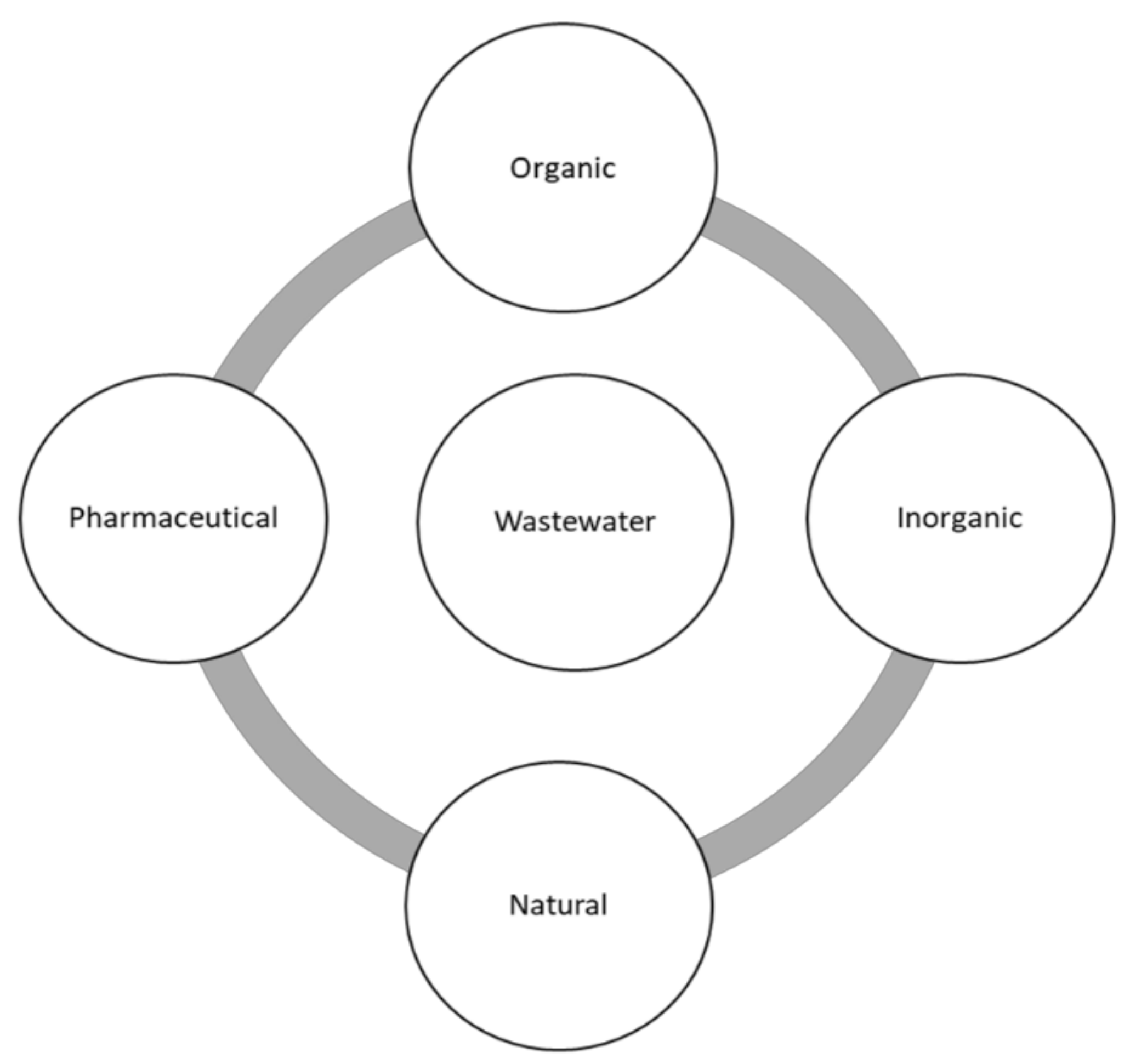
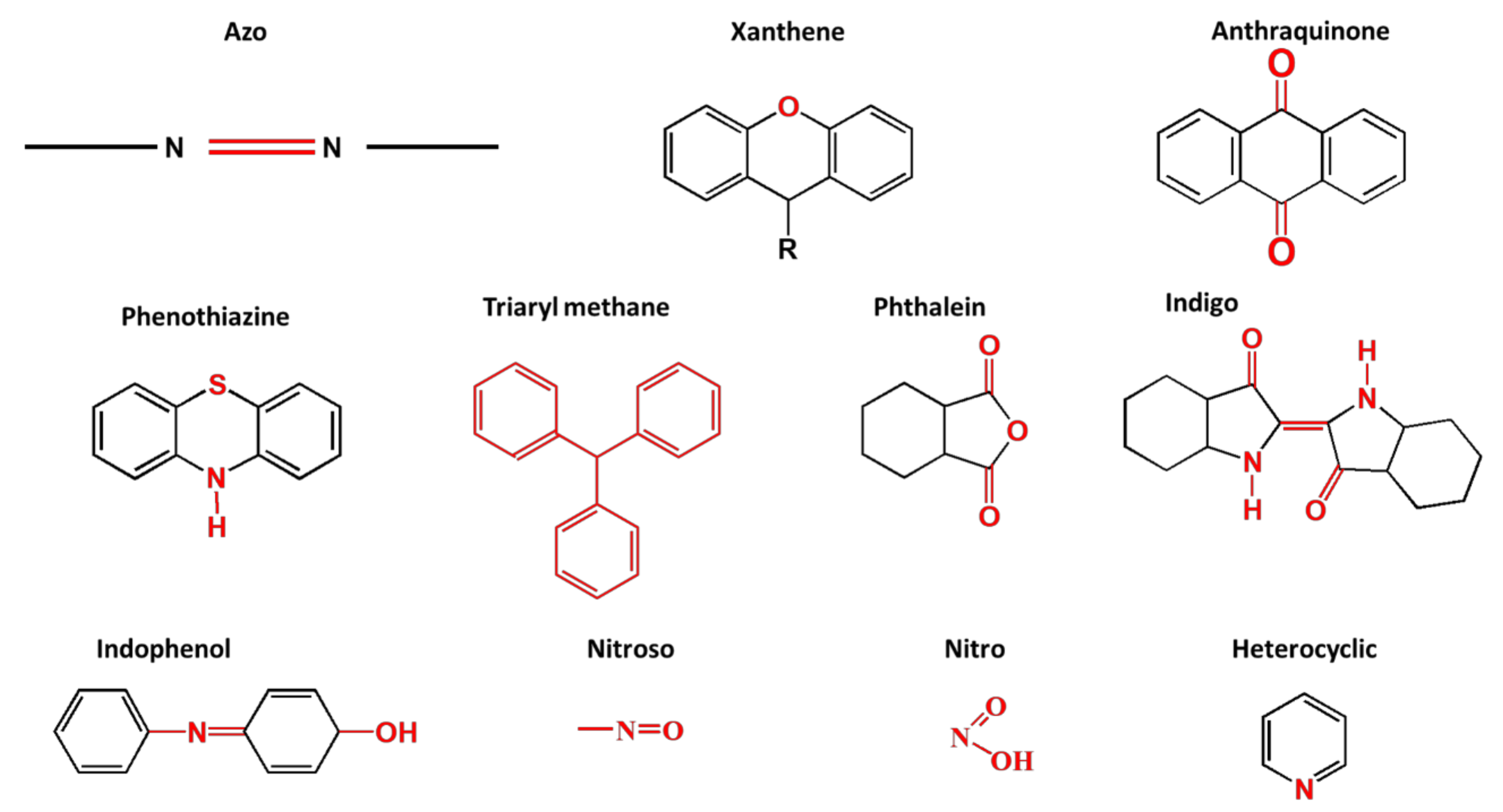
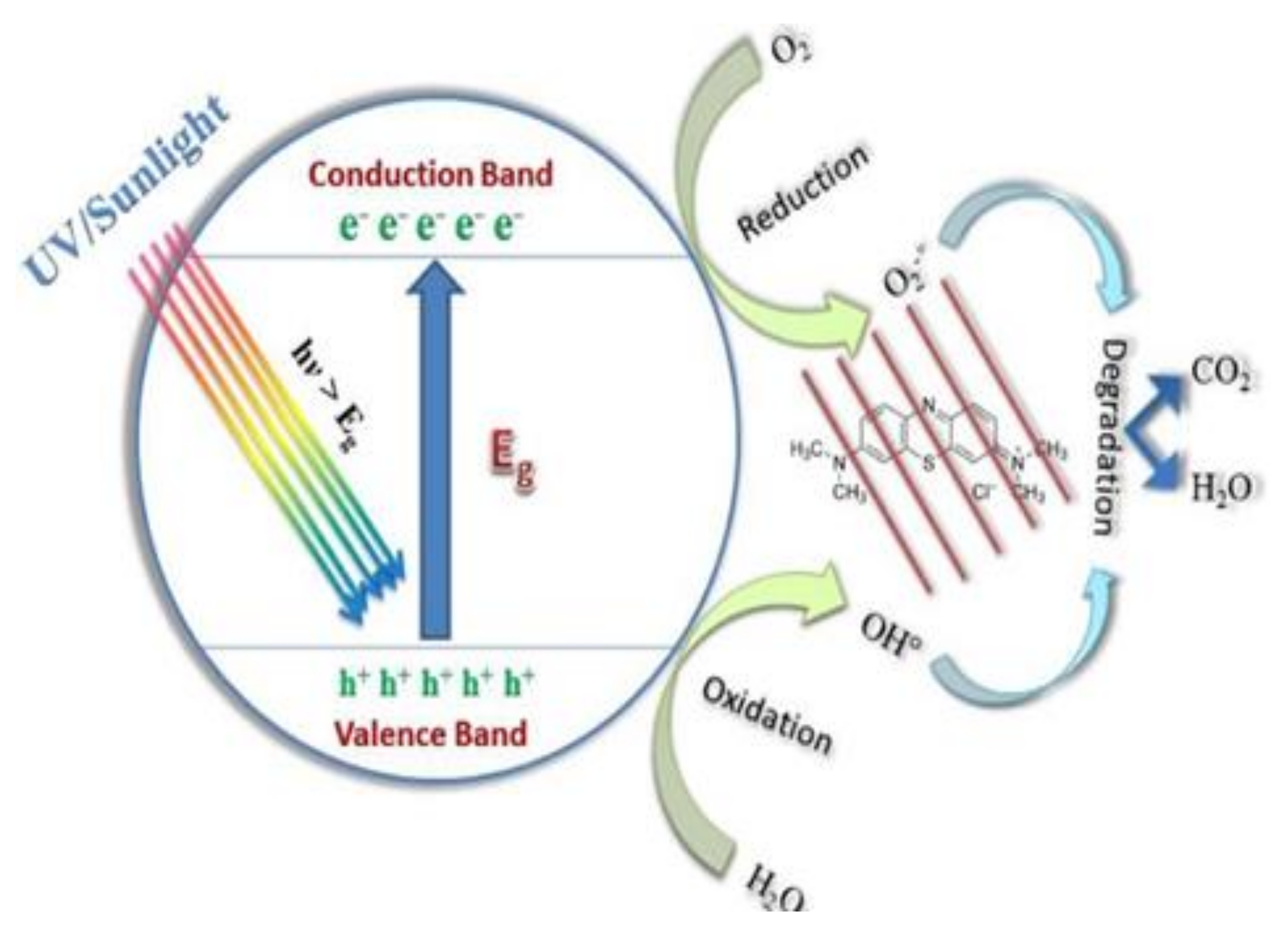

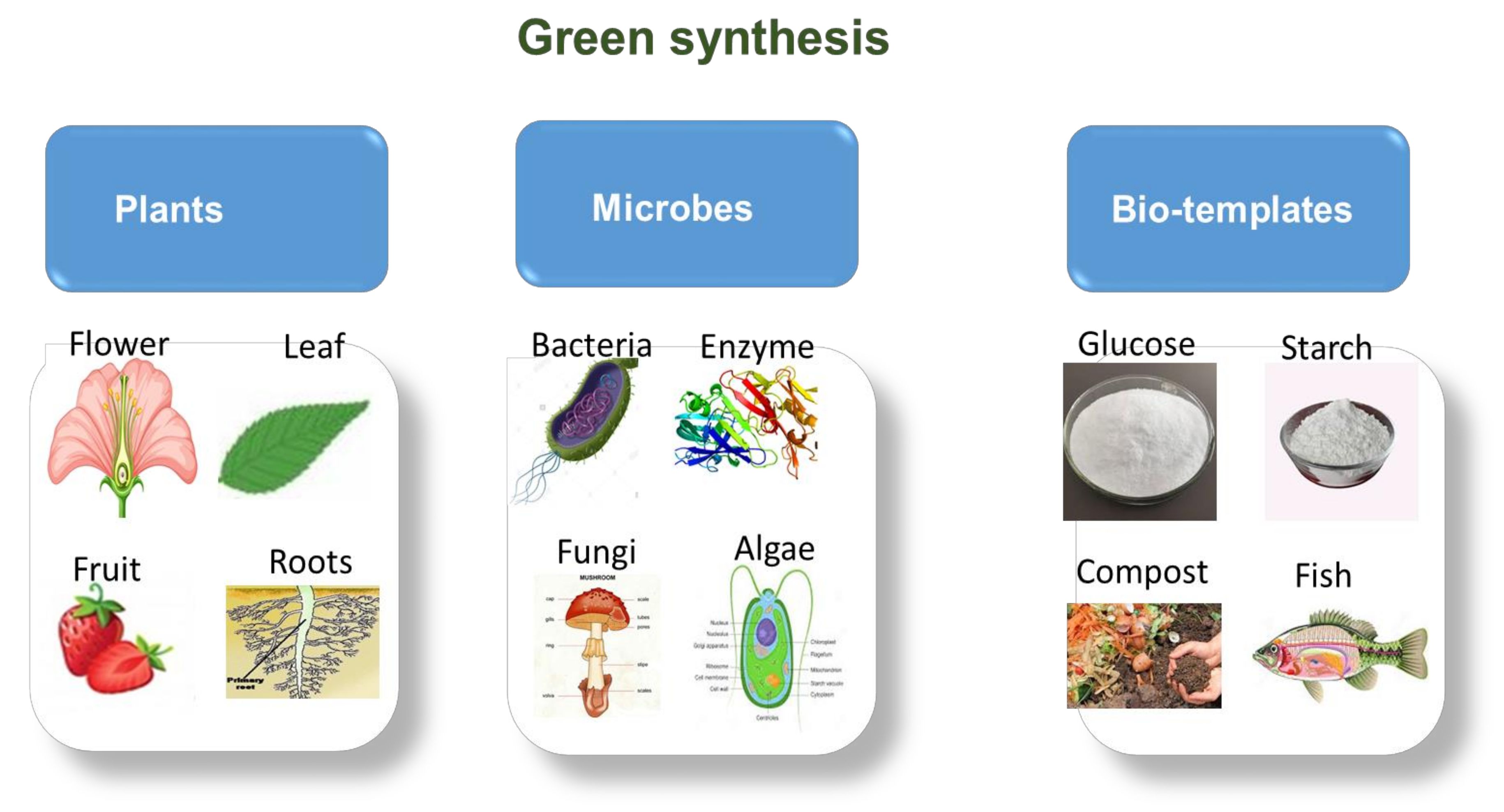
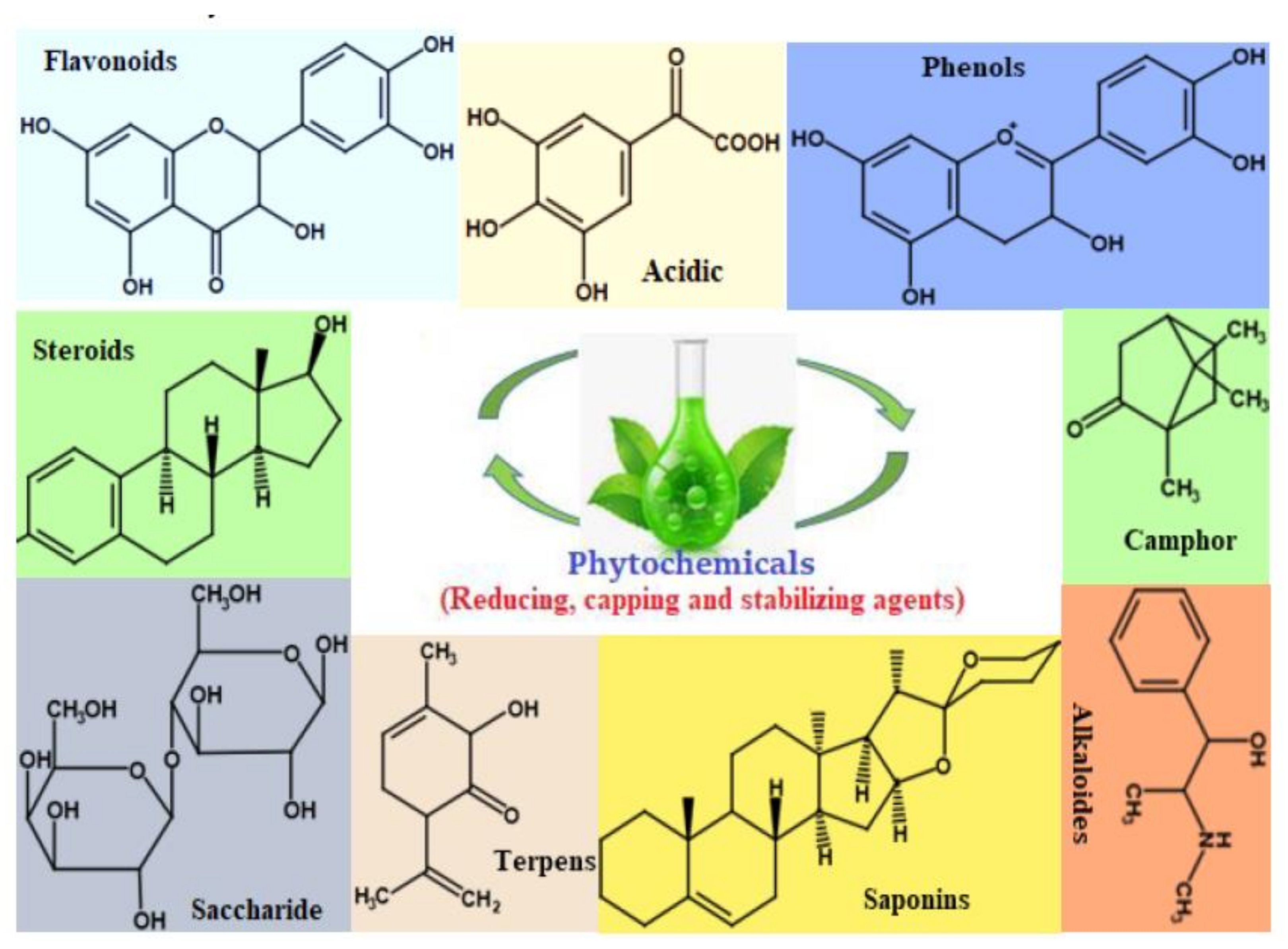
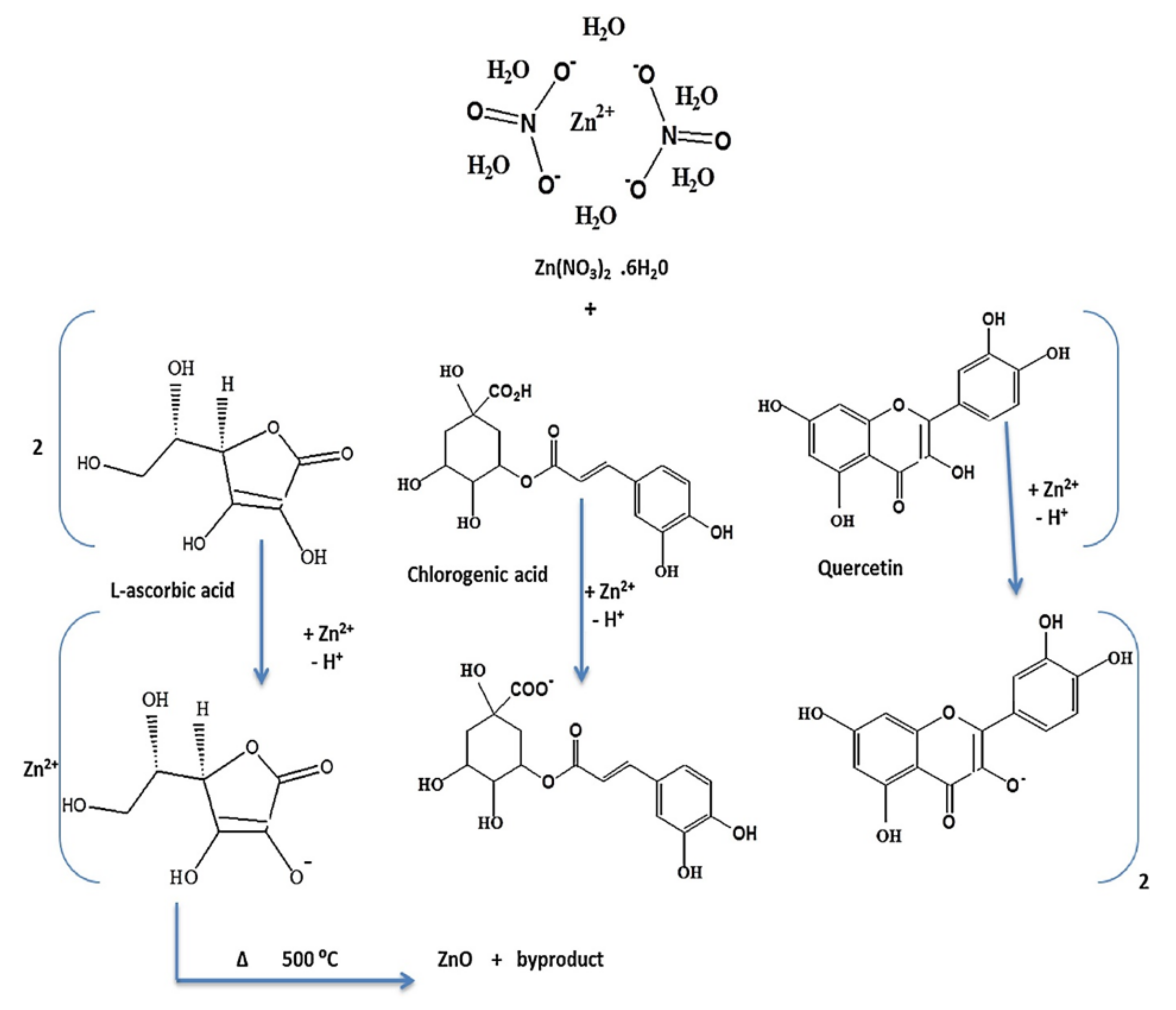
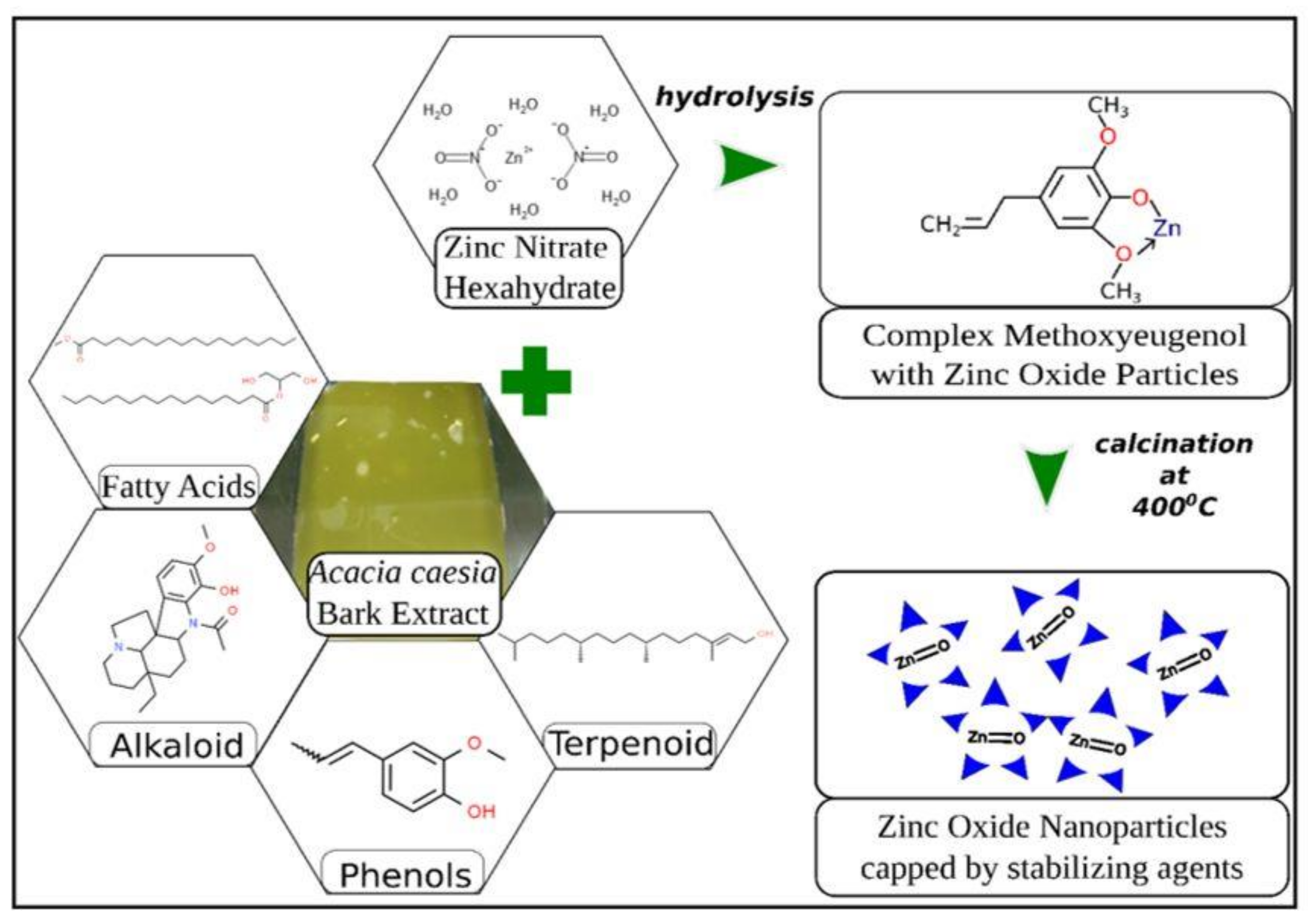
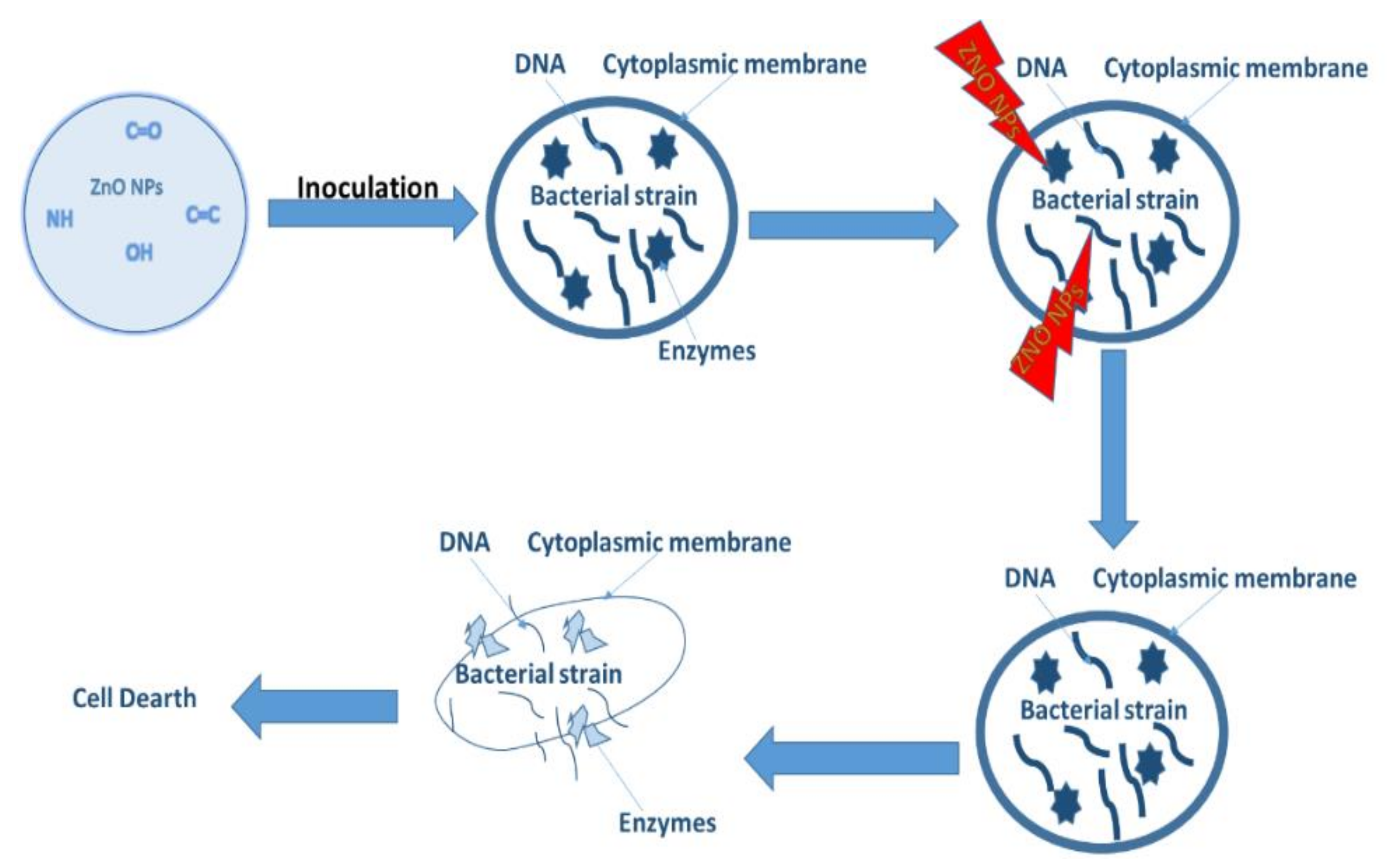
| Structure | Dye Name | Chromophore | Source, Properties and Toxicity | Uses | Ref |
|---|---|---|---|---|---|
 | MB | Phenothiazine | Synthetic dye Biological properties such as antioxidant, antimalarial, antidepressant and cardioprotective properties Carcinogenic and mutagenic | Wood, leather, plastic and silk | [47,48,49] |
 | MG | Triaryl methane | Natural dye From minerals and used for mineral pigmentation Used as an antimicrobial agent for aquaculture | Food, aquaculture, textile and dyeing Silk, leather paper | [44,49,50,51,52] |
 | AY | Azo | Wool, silk, nylon, fabrics | Textile, paints, leather and cosmetics | [53,54] |
 | RHB | Xanthene | Synthetic, wastewater, tracer and fluorescence nature | Printing, paper, paints, leather, food and plastic | [55,56] |
 | MO | Azo | Synthetic and has sensing properties | Titration indicator, textile printing, food | [57,58,59,60] |
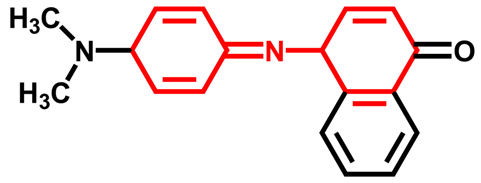 | IB | Indophenol | Synthetic Detecting ammonia | Detection and dyeing | [61] |
 | CR | Azo | Synthetic Dyeing Very harmful (Carcinogenic) | Printing, cotton wool, textile, clothing, food and cosmetics | [62] |
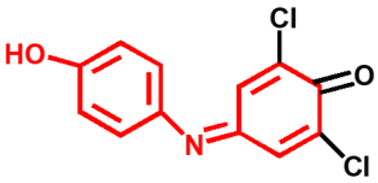 | DCPIP | Indophenol | Both naturally and synthetic Naturally from fruits and vegetables They also possess biological properties Detection of ammonia (NH3) | Titration and dyeing | [63,64,65,66,67] |
 | NB | Nitro | Synthetic Dyeing Toxic and mutagenic B2 Carcinogen | Form aniline, and pesticides, used in pharmaceutical industries, manufacture explosives and also used for dyeing | [68] |
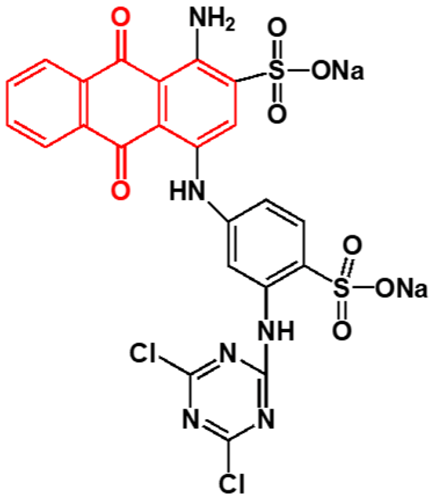 | RD4 | Anthraquinones | Synthetic | Cosmetics, food, paper, pharmaceutical and leather | [69,70] |
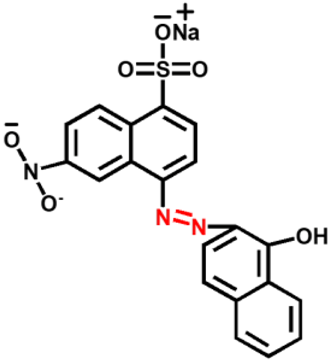 | EBT | Azo | Synthetic Hazardous and carcinogenic | Dyeing multifibers, wool, nylon, silk Titration indicator Formation of coloured complexes | [61,71,72] |
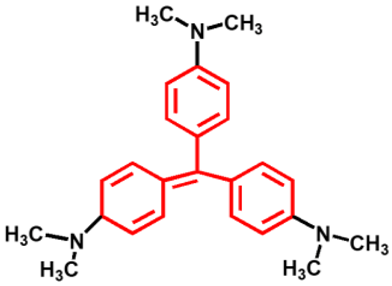 | CV | Triarylmethane | Synthetic High thermal, reduced scattering and intrinsic polarization Difficult to crystalise Carcinogenic | Medicinal—Active ingredient in gram staining and antibacterial agent Textile—sensitiser for photoconductivity Laboratory—pH indicator, disinfectant in humans and animals | [44,61,73,74] |
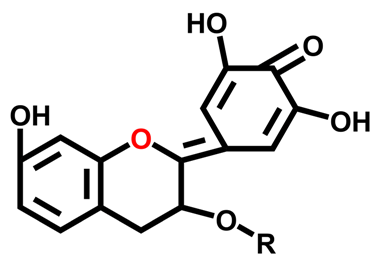 | A | Anthraquinones | Natural from fruits and vegetables (red cabbage, grapes, berries and many moreIt has biological properties such as anticancer, anti-inflammatory, antimicrobial, antiobesity Sensitive to light, pH, heat and oxygen | Titration Indicator | [75,76] |
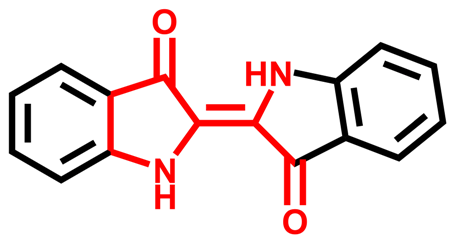 | I | Indigo | Natural and synthetic Naturally—has biological properties like antiseptic but toxic if ingested in large volumes. Synthetic—Carcinogenic | Formulate artifacts like paintings, Chinese temple decorations, mummy clothes, Japanese woodblocks and dyeing | [77] |
| Type of Method | Advantage | Disadvantage | References |
|---|---|---|---|
| Reverse Osmosis | Higher desalination High water permeability Development of thin film composite membranes | Tedious process Generate different environmental impact Energy-intensive Membrane Fouling High maintenance and operational cost | [84] |
| Adsorption | Simple in process design Regenerative process | Disposal of used adsorbent Difficult in regenerating used adsorbent Desorption Adsorbents tend to exhibit low adsorption capacity from adsorbents Displays slow reaction Expensive | [85,86] |
| Ion exchange | Use of resin or adsorbents Easily resin regeneration Rapid, efficient and effective process Suitable resins for selective pollutants | Require pre-treatment methods Capacitive deionisation Ionic competition Sensitive to pH Complex operation Fouling matrix | [87] |
| Biological | Natural process Eco friendly Less costly | Challenge in degrading non-biological materials | [88] |
| Flocculation | Biodegradable Preferred for removing fine particles Removes colour, metals and turbidity | Generation of high-volume sludge Difficulty in handling sludge Toxic if improperly used Require multiple processes High operational and disposal cost | [89,90] |
| AOP | Complete degradation of pollutants Involves strong oxidising agents Eco-friendly Less costly | Slow process | [10] |
| Plant Source | Zinc Source | Shape | Size (nm) | Refs |
|---|---|---|---|---|
| Azadira indica | nitrate | Blocks/bars | 40–100 | [26] |
| Rumex dentatus | nitrate | spherical | 6.19 | [40] |
| Moringa oleifera | acetate | Spheres | 40–45 | [67] |
| Commelina benghanlensis | nitrate | Flakes/spheres | 20–140 | [120] |
| Sapindus rarak DC | nitrate | Polydispersed/irregular | 50–95 | [118] |
| Pongamia pinnata | nitrate | Spheres | 26 | [68] |
| Aloe barbadensis | nitrate | Spheres | 25–40 | [121] |
| Prosopis forcta | acetate | Spheres | 20–25 | [69] |
| Camellia sinesis | acetate | Rods | 10–20 | [121] |
| Solanum nigrum | nitrate | Quasi spherical | 29–79 | [72] |
| Monsonia burkeana | chloride | Hexagonal wurtzite | 20 | [100] |
| Artocarpus heterophyllus | chloride | Hexagonal | 15–25 | [73] |
| Ceropegia candelabrum | nitrate | - | 12–35 | [78] |
| Ulva fasciata | chloride | Rods | 70 | [79] |
| Stevia | acetate | Rectangular | 10–90 | [80] |
| Bauhinia tomentosa | sulfate | 22–94 | [81] | |
| Sutherlandia frutescens | nitrate | Spherical | 5–25 | [25] |
| Reductant | Organic Pollutant | Degradation Conditions | Efficiency (%) | Radiation Time (H) | Refs |
|---|---|---|---|---|---|
| Citrus maxima (Pomelo) | MB | 5 ppm, 150 mg, pH = 11, UV light | Over 90 | 0.83 | [94] |
| Bacillus licheniformis | MB | 100 ppb, 0,25 g/L, Hg lamp, | 85 | 1 | [123] |
| Vitis labuska | MB | 5 ppm, 100 mg, Hg Lamp, pH = 10 | 100 | 3 | [97] |
| Hagenia abyssinica | MO | 15 ppm, 40 mg, sunlight, | 83 | 2 | [124] |
| Averrhoe carambola | CR | 100 ppm, 50 mg, | 93 | 3 | [125] |
| Musa acuminate | MB | 2 × 10−5 M, 20 mg, UV light, | 98 | 3 | [126] |
| Calliandra haematocephala | MB | 20 ppm, 50 mg, sunlight, | 88 | 4.5 | [127] |
| Monsonia burkeana | MB | 20 ppm, 20 mg, UV light | 48 | 0.8 | [100] |
| Trigonella foenum graecum | MB | 25 ppm, pH = 11, UV light | 88 | 1.5 | [128] |
| Hippophae rhamnoides | MG EY | 10 ppm, 0.5 mg, UV linker | 89 95 | 3 | [129] |
| Pithecellobium dulce | MB | 1 Mm, 15 mg, photorector | 63 | 2 | [130] |
| Abelmoschus esculentus musilage | Rhb | 125 mg, Hg reactor | 100 | 1 | [131] |
| Calotropis praera leaves | MB | 20 ppm, 1.5 g/L, UV light | 81 | 1.4 | [132] |
| Eucalyptus globulus | MB and MO | 10 ppm, 30 mg, UV light | 98.3 | 0.5 | [133] |
| Artocarpus gomezianus | MB | 5 ppm, 50 mg, sunlight & UV light, pH = 10 | 90 | 2 | [134] |
| Artocarpus heterophyllus | CR | 20 ppm, pH = 9 | >90 | 1 | [135] |
| Plectranthus amboinicus | MR | 1 × 10−4 M, 20 mg, UV light | 92 | 3 | [136] |
| Punica granatum | R-250 | 5 ppm, 1 g/L, | 93 | 3 | [137] |
| Terminalia chebula | 5 ppm, 1 g/L, | 5 | [138] | ||
| Commelina benghanlensis | MB | 20 ppm, 30 mg, UV light, pH = 4 | 81 | 2 | [139] |
| Rueli tuberosa | MB MG | 10 ppm, 20 mg, UV light | 94 92 | 2.5 | [52] |
| Plant Extract | Shape | Sizenm | Pollutants | Method | Inhibition | Refs |
|---|---|---|---|---|---|---|
| Camellia Sinesis | hexagonal | 16 | K. pneumoniai E. coli P. aeruginosa S. aureus | Agar-well diffusion | 10.3 nm 3.3 nm 5.3 nm | [10] |
| Rueli tuberosa | Rod | 40–50 | E. coli, S. aureus | Agar-well diffusion | - | [52] |
| Aspergillus niger | Sphere | 84–91 | E. coli, S. aureus | Disc diffusion | 12 nm 10 nm | [144] |
| Citrus maxima | Sphere | 20 | E. coli, S. aureus K. aerogenes | Disc diffusion | 1.17 nm 3.53 nm 2.03 nm | [122] |
| Dried faecal matter | Oval | 60–120 | S. typhimurium B. subtilis | Disc diffusion | 1.16 nm 1.08 nm | [142] |
| Ceropegia candelabum | Hexagonal | 12–35 | E. coli, S. aureus B. sub | Disc diffusion | 0.00 mm 14.83 mm 10.66 mm | [145] |
| Aloe vera | Sphere | 8–18 | E. coli, S. aureus P. aeruginosa | Disc diffusion | 22.1 mm 21.9 mm 18.8 mm | [146] |
| Passiflora caerulea | Hexagonal | 16 | E. coli, S. aureus P. aeruginosa K. pneumonia | Optical density measurement | 8.33 mm 8.33 mm 7.33 mm 7.00 mm | [147] |
| Aeronomas hydrophia | Oval and spherical | 57 | A. flavus P. aeruginosa | Disc diffusion | 19 mm 22 mm | [143] |
| Ailanthus altissima | Sphere | 5–18 | E. coli, S. aureus | Disc diffusion | 18 mm 20 mm | [148] |
| Hageniaabyssinica | Hexagonal | 27 | E. coli, S. aureus S. epidermis K. pneumonia | Disc diffusion | 19 ± 1.0 19.33 ± 0.58 21 ± 1.0 18 ± 1.0 | [124] |
| Pithecellobium dulce | Sphere | 30 | A. flavus A. niger | - | 40% 43% | [130] |
| Vitis labruska | Hexagonal | 20 | E. coli, S. aureus | Disc diffusion | 39.6 ± 0.28 30 ± 0.57 | [97] |
| Precursor | Plant | Shape | Size (nm) | Poll | Conc | % Removal | Time (min) | Refs |
|---|---|---|---|---|---|---|---|---|
| ZnO-CuO | Calotropis gigantean | Spheres | 10–40 | MB | 5 ppm | 98 | 105 | [140] |
| Ag/ZnO | Oak | Sphere | 19 | BV3 | 100 µM | 94 | 120 | [114] |
| Fe3O4/SiO2/ZnO | Fructose | Quazi sphere | 38 | CR | 3 ppm | 85 | 80 | [44] |
| ZnO-SnO2 | Sutherlendia Frutescens | Spheres | 5–60 | MB | 20 ppm | 88 | 120 | [113] |
Publisher’s Note: MDPI stays neutral with regard to jurisdictional claims in published maps and institutional affiliations. |
© 2022 by the authors. Licensee MDPI, Basel, Switzerland. This article is an open access article distributed under the terms and conditions of the Creative Commons Attribution (CC BY) license (https://creativecommons.org/licenses/by/4.0/).
Share and Cite
Mahlaule-Glory, L.M.; Hintsho-Mbita, N.C. Green Derived Zinc Oxide (ZnO) for the Degradation of Dyes from Wastewater and Their Antimicrobial Activity: A Review. Catalysts 2022, 12, 833. https://doi.org/10.3390/catal12080833
Mahlaule-Glory LM, Hintsho-Mbita NC. Green Derived Zinc Oxide (ZnO) for the Degradation of Dyes from Wastewater and Their Antimicrobial Activity: A Review. Catalysts. 2022; 12(8):833. https://doi.org/10.3390/catal12080833
Chicago/Turabian StyleMahlaule-Glory, Louisah M., and Nomso C. Hintsho-Mbita. 2022. "Green Derived Zinc Oxide (ZnO) for the Degradation of Dyes from Wastewater and Their Antimicrobial Activity: A Review" Catalysts 12, no. 8: 833. https://doi.org/10.3390/catal12080833
APA StyleMahlaule-Glory, L. M., & Hintsho-Mbita, N. C. (2022). Green Derived Zinc Oxide (ZnO) for the Degradation of Dyes from Wastewater and Their Antimicrobial Activity: A Review. Catalysts, 12(8), 833. https://doi.org/10.3390/catal12080833








